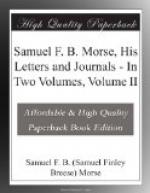“I sent the picture to the Exhibition at Somerset House which opens on the 3d of May, and have the satisfaction not only of having it received, but of having the praises of the council who decide on the admission of pictures. Six hundred were refused admission this year, so you may suppose that a picture (of the size of mine, too) must possess some merit to be received in preference to six hundred. A small picture may be received even if it is not very good, because it will serve to fill up some little space which would otherwise be empty, but a large one, from its excluding many smaller ones, must possess a great deal in its favor in order to be received.
“If you recollect I told you I had completed a model of a single figure of the same subject. This I sent to the Society of Arts at the Adelphi, to stand for the prize (which is offered every year for the best performance in painting, sculpture, and architecture and is a gold medal).
“Yesterday I received the note accompanying this, by which you will see that it is adjudged to me in sculpture this year. It will be delivered to me in public on the 13th of May or June, I don’t know which, but I shall give you a particular account of the whole process as soon as I have received it.... I cannot close this letter without telling you how much I am indebted to that excellent man Mr. Allston. He is extremely partial to me and has often told me that he is proud of calling me his pupil. He visits me every evening and our conversation is generally upon the inexhaustible subject of our divine art, and upon home which is next in our thoughts.
“I know not in what terms to speak of Mr. Allston. I can truly say I do not know the slightest imperfection in him. He is amiable, affectionate, learned, possessed of the greatest powers of mind and genius, modest, unassuming, and, above all, a religious man.... I could write a quire of paper in his praise, but all I could say of him would give you but a very imperfect idea of him....
“You must recollect, when you tell friends that I am studying in England, that I am a pupil of Allston and not Mr. West. They will not long ask who Mr. Allston is; he will very soon astonish the world. He claims me as his pupil, and told me a day or two since, in a jocose manner, that he should have a battle with Mr. West unless he gave up all pretension to me.”
We gain further information concerning Morse’s first triumphs, his painting and his statuette from the following reminiscences of a friend, Mr. Dunlap:—
“It was about the year 1812 that Allston commenced his celebrated picture of the ‘Dead Man restored to Life by touching the Bones of Elisha,’ which is now in the Pennsylvania Academy of Arts. In the study of this picture he made a model in clay of the head of the dead man to assist him in painting the expression. This was the practice of the most eminent old masters. Morse had begun a large picture to come out before the British public at the Royal Academy Exhibition. The subject was the ’Dying Hercules,’ and, in order to paint it with the more effect, he followed the example of Allston and determined to model the figure in clay. It was his first attempt at modelling.




